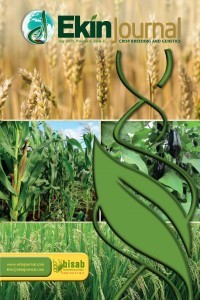Genetic Variability among Winter Cereal Genotypes for Response to Protein Hydrolysate (PH) for Grain Yield and Its Attributes
Genetic Variability among Winter Cereal Genotypes for Response to Protein Hydrolysate (PH) for Grain Yield and Its Attributes
Amino acid human hair "waste" hydrolysate, cereals, wheat, triticale, barley,
___
- Calvo P, Nelson L, and Kloepper JW, (2014). Agricultural uses of plant biostimulants. Plant Soil 383:3-41. doi: 10.1007/s11104-014-2131-8.
- Colla G, Rouphael Y, Canaguier R, Svecova E and Cardarelli M, (2014). Biostimulant action of a plant-derived protein hydrolysate produced through enzymatic hydrolysis. Front. Plant Sci. 5:448. doi: 10.3389/fpls.2014.00448.
- Colla G, Nardi S, Cardarelli M, Ertani A, Lucini L and Canaguier R, (2015). Protein hydrolysate as biostimulants in horticulture. Sci. Horti. 96:28-38. Doi: 10.1016/j.scienta.2015.08.037
- Colla G, Hoagland L, Ruzzi M, Cardarelli M, Bonini P, Canaguier R and Rouphael Y, (2017) Biostimulant action of protein hydrolysates: Unraveling their effects on plant physiology and microbiome. Front. Plant Sci. 8:2202. doi: 10.3389/fpls.2017.02202
- Ertani A, Pizzeghello D, Francioso O, Sambo P, Sanchez-Cortes S and Nardi S, (2014). Capsicum chinense L. growth and nutraceutical properties are enhanced by biostimulants in a long-term period: chemical and metabolomic approaches. Front. Plant Sci. 5:1-12.
- Halpern M, Bar-Tal A, Ofek M, Minz D, Muller T and Yermiyahu U, (2015). The use of biostimulants for enhancing nutrient uptake. Adv. Agron. 130:141-174. doi: 10.3389/fpls.2017.00597.
- Kumar P, Behl J , Singh M and Behl R, (2021). Efficacy of protein hydrolysate (plant force advance) based formulation on cotton yield. Ekin Journal of Crop Breeding and Genetics, 7(1):43-47. https://dergipark.org.tr/en/pub/ekinjournal/ issue/60162/872676
- Lucini L, Rouphael Y, Cardarelli M, Canguier R, Kumar P and Colla G, (2015). The effect of a plant-derived biostimulant on metabolic profiling and crop performance of lettuce grown under saline conditions. Sci. Hortic. 182:124-133.
- Mostafa MA, Manal Mubarak NS, Khalil G and Mohamad H, (2014). Manufacturing amino acids bio fertilizers from agricultural wastes-Effect of synthetic organic fertilizers on the growth and yield of some forage crops as well as some soil properties J. Soil Sci. and Agric. Eng., Mansoura Univ., 5(2):279-294.
- Nardi S, Pizzeghello D, Schiavon M and Ertani A, (2016). Plant biostimulants: Physiological responses induced by protein hydrolyzed based products and humic substances in plant metabolism. Sci. Agric. 73:18-23. doi: 10.1590/0103-9016-2015-0006.
- Popko M, Michalak I, Wilk R, Gramza M, Chojnacka K and Górecki H, (2018). Effect of the new plant growth biostimulants based on amino acids on yield and grain quality of winter wheat. Molecules. 23(2):470. DOI: 10.3390/ molecules23020470.
- Subbarao SB, Aftab Hussain IS and Ganesh PT, (2015). Biostimulant activity of protein hydrolysate: Influence on plant growth and yield. J Plant Sci Res. 2(2):125.
- Teixeira WF, Fagan EB, Soares LH,Soares JN, Reichardt K and Neto DD, (2018). Seed treatment and foliar application of amino acids improve variables of nitrogen metabolism and productivity in soybean Crop. Front. Plant Sci. 9:396.doi: 10.3389/fpls.2018.00396
- Yadav S and Khosla B, (2020). Biostimulant effect of poultry feather hydrolysate on maize (Zea mays L.) seedlings. Annals of Biology 36 (3):508-512. Vasudeva, V. (2022). Explained What are India’s plans to avert a wheat crisis?
- ISSN: 2149-1275
- Yayın Aralığı: Yılda 2 Sayı
- Başlangıç: 2015
- Yayıncı: Bitki Islahçıları Alt Birliği
Parul RANA, Om P. BISHNOI, Harsh CHAURASIA, Rishi K. BEHL
Pardeep KUMAR, Pritam YADAV, Pravin Kumar SHARMA, Machiavelli SINGH, Rishi K. BEHL
Registration of “Bossa 159” Cotton (Gossypium hirsutum L.) Variety
Mukesh KUMAR, Sushil SHARMA, Manoj KUMAR, Amarjeet NIBHORIA, Bijender Singh YADAV
Registration of “Sayım 40” Winter Barley (Hordeum vulgare L.) Variety
Namuk ERGÜN, İsmail SAYİM, Sinan AYDOĞAN, Melih BİLİR, Emre KARAHAN, Gülden Çetin ÖZKAN
Registration of “Sinanbey” Winter Feed Barley (Hordeum vulgare L.) Variety
Namuk ERGÜN, Sinan AYDOĞAN, İsmail SAYİM, Melih BİLİR, Emre KARAHAN, Gülden Çetin ÖZKAN
Surinder Singh BISHT, Rishi K. BEHL, Chander KISHOR, Rajesh Kumar ARYA
İrfan ÖZTÜRK, Banu TÜLEK, Remzi AVCI, Turhan KAHRAMAN, Adnan TÜLEK
Registration of "Samsoy" Soybean [Glycine max (L.) Merr.] Variety
Mehmet ERDOĞMUŞ, Meral ERGİN, Serkan YILMAZ, Seyit Ahmet EROL, Celal BAYRAM
Esra CEBECİ, H. Filiz BOYACI, Yıldız DOĞAN, Laura TOPPINO, Giuseppe L. ROTINO
